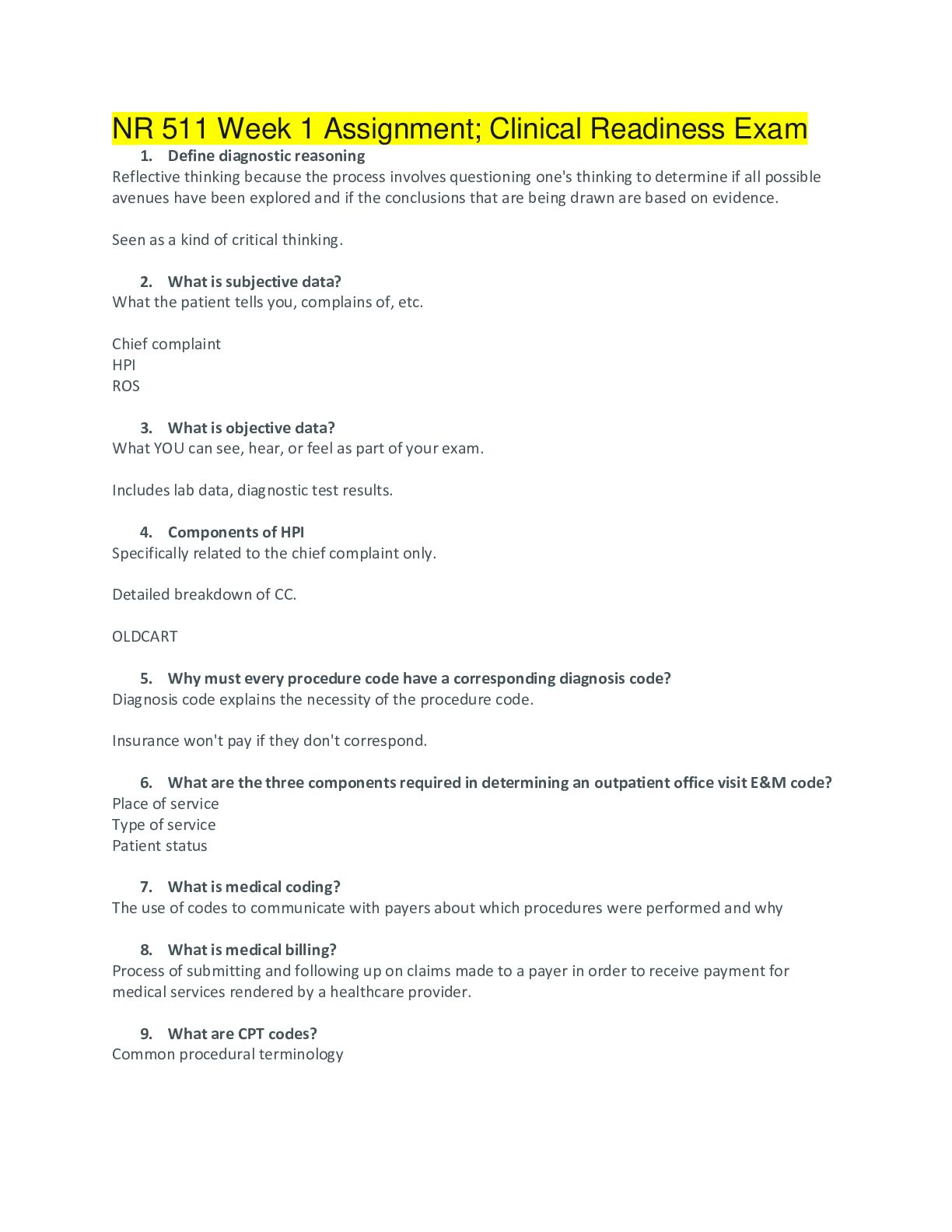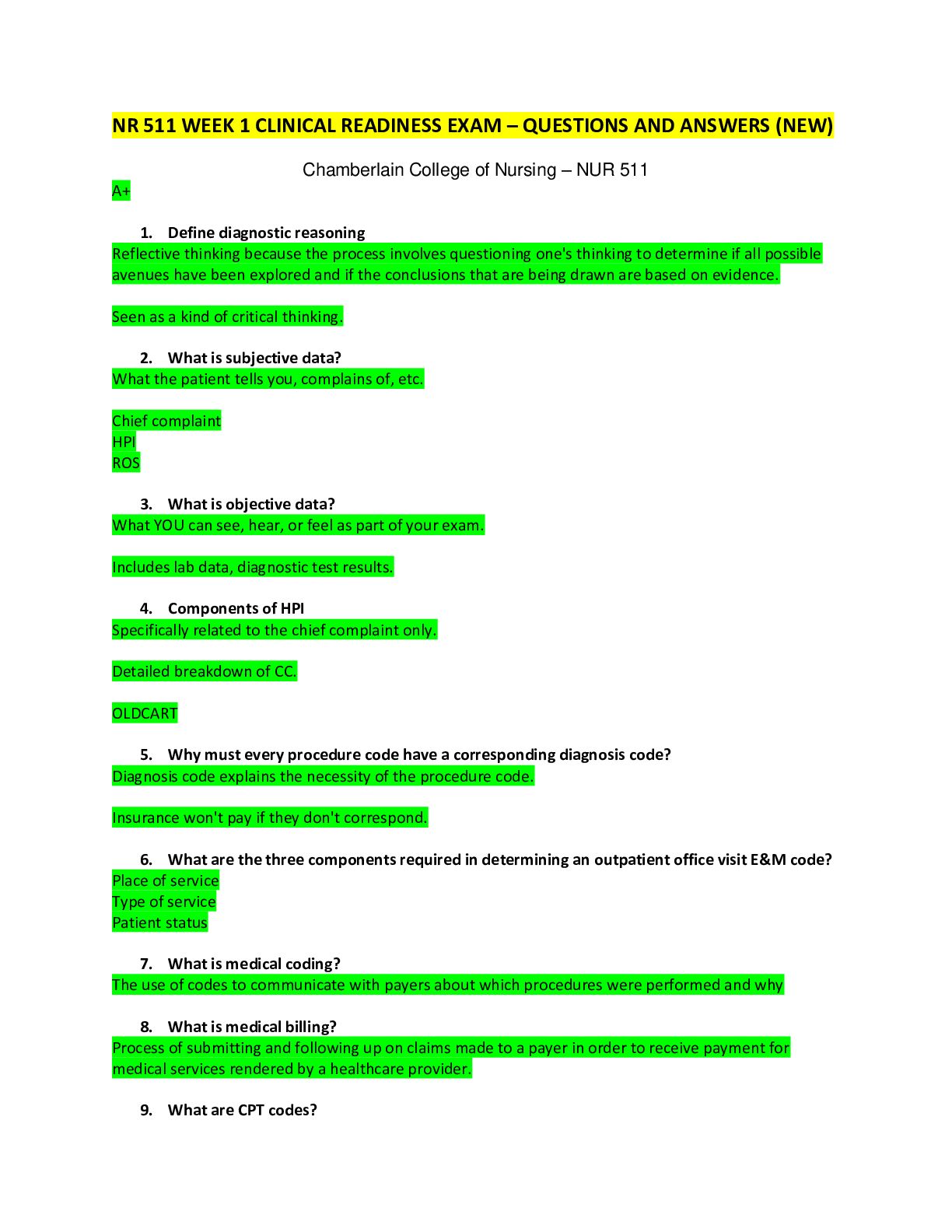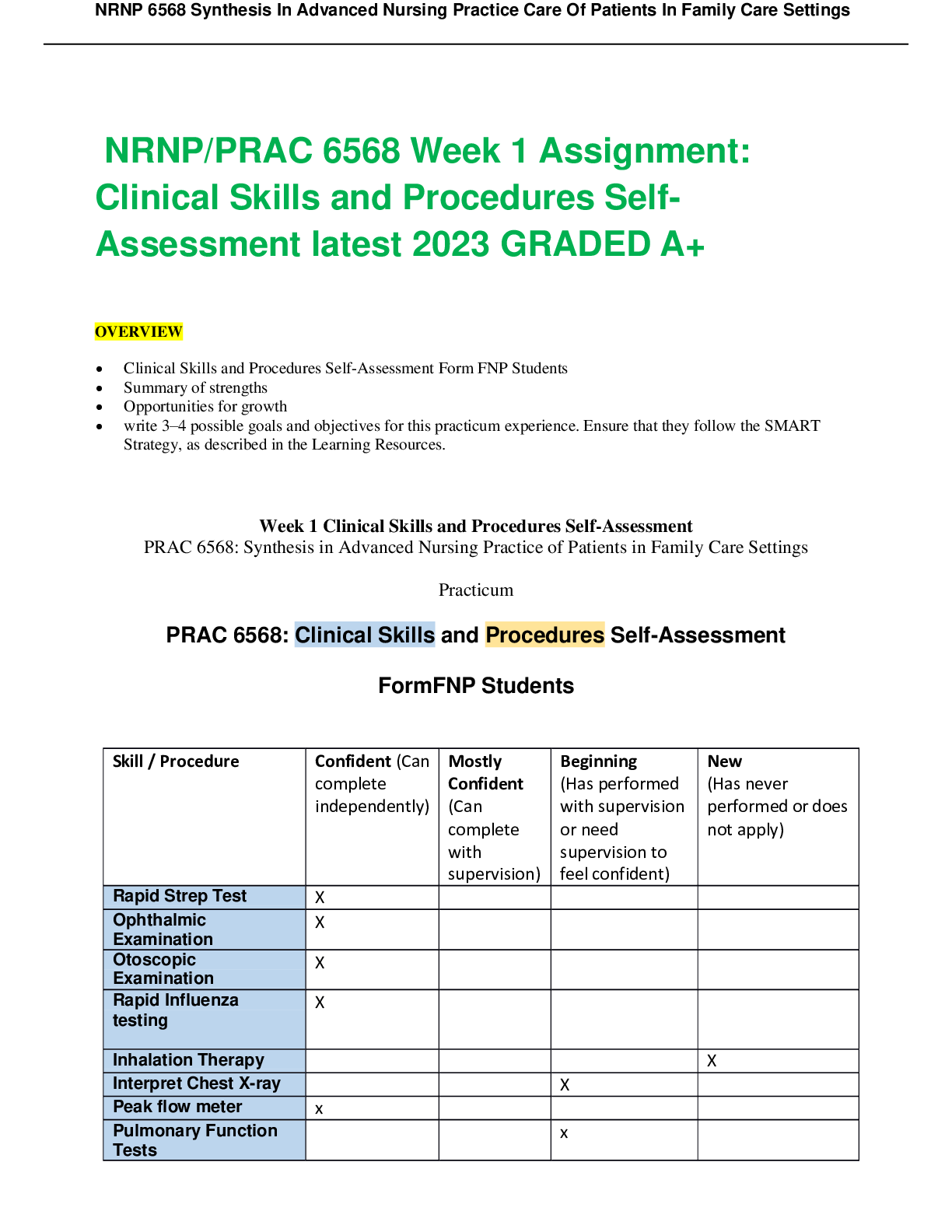*NURSING > EXAM > NR 511 Week 1 Assignment: Reflection on Learning/ Clinical Readiness Exam (TOP GRADE) (All)
NR 511 Week 1 Assignment: Reflection on Learning/ Clinical Readiness Exam (TOP GRADE)
Document Content and Description Below
1. Define diagnostic reasoning Reflective thinking because the process involves questioning one's thinking to determine if all possible avenues have been explored and if the conclusions that are bein... g drawn are based on evidence. Seen as a kind of critical thinking. 2. What is subjective data? What the patient tells you, complains of, etc. Chief complaint HPI ROS 3. What is objective data? What YOU can see, hear, or feel as part of your exam. Includes lab data, diagnostic test results. 4. Components of HPI Specifically related to the chief complaint only. Detailed breakdown of CC. OLDCART 5. Why must every procedure code have a corresponding diagnosis code? Diagnosis code explains the necessity of the procedure code. Insurance won't pay if they don't correspond. 6. What are the three components required in determining an outpatient office visit E&M code? Place of service Type of service Patient status 7. What is medical coding? The use of codes to communicate with payers about which procedures were performed and why 8. What is medical billing? Process of submitting and following up on claims made to a payer in order to receive payment for medical services rendered by a healthcare provider. 9. What are CPT codes? Common procedural terminology Offers the official procedural coding rules and guidelines required when reporting medical services and procedures performed by physician and non-physician providers. 10. What are ICD codes? International classification of disease Used to provide payer info on necessity of visit or procedure performed. 11. What is specificity? The ability of the test to correctly detect a specific condition. If a patient has a condition but test is negative, it is a false negative. If a patient does NOT have a condition but the test is positive, it is a false positive. 12. What is sensitivity? Test that has few false negatives. Ability of a test to correctly identify a specific condition when it is present. The higher the sensitivity, the lesser the likelihood of a false negative. 13. What is predictive value? The likelihood that the patient actually has the condition and is, in part, dependent upon the prevalence of the condition in the population. If a condition is highly likely, the positive result would be more accurate. 14. What elements need to be considered when developing a plan? Pt's preferences and actions Research evidence Clinical state/circumstances Clinical expertise 15. What are the components of medical decision making in E&M coding? Risk Data Diagnosis The more time and consideration involved in dealing with a pt, the higher the reimbursement from the payer. Documentation must reflect MDM! 16. Correctly order the E&M office visit codes based on complexity from least to most complex. New patient: 1. Minimal/RN visit: 99201 2. Problem focused: 99202 3. Expanded problem focused: 99203 4. Detailed: 99204 5. Comprehensive: 99205 Established patient: 1. Minimal/RN visit: 99211 2. Problem focused: 99212 3. Expanded problem focused: 99213 4. Detailed: 99214 5. Comprehensive: 99215 17. Define the components of a SOAP note S: subjective (what the pt tells you) CC HPI PMH Fam Hx Social Hx ROS O: objective (what you can see, hear, feel on exam) Physical findings VS General survey HEENT Etc... A: assessment Global assessment of pt including differentials in order from most to least likely. Combination of subjective and objective info. List of dx addressed and billed for at the visit P: plan What you will Rx When to come back Diagnostic tests Pt education 18. What are purposes of the written H&P in relation to the importance of documentation? Important reference document that gives concise info about the pt's Hx and exam findings. Outlines a plan for addressing issues that prompted the visit. Info should be presented in a logical fashion that prominently features all data relevant to the pt's condition. Is a means of communicating info to all providers involved in the pt's care. Is a medical-legal document. Is essential in order to accurately code and bill for services. 19. When is a pt considered a "new" pt? If that pt has never been seen in that clinic or by that group of providers OR if the pt has not been seen in the past 3 years. 20. What does a well-rounded clinical experience mean? Includes seeing kids from birth through young adult visits for well child and acute visits, as well as adults for wellness or acute/routine visits. Seeing a variety of pt's, including 15% of peds and 15% of women's health of total time in the program. 21. What are the maximum number of hours that time can be spent "rounding" in a facility during clinicals? No more than 25% of total practicum hours in the program 22. What are 9 things that must be documented in the clinical encounter logs? Date of service Age Gender and ethnicity Visit E&M code CC Procedures Tests performed and ordered Dx Level of involvement (mostly student, mostly preceptor, together, etc.) 23. What is the first "S" in the SNAPPS presentation? Summarize: present the pt's H&P findings 24. What is the "N" in the SNAPPS presentation? Narrow: based on the H&P findings, narrow down to the top 2-3 differentials 25. What is the "A" in the SNAPPS presentation? Analyze: analyze the differentials. Compare and contrast H&P findings for each of the differentials and narrow it down to the most likely one 26. What is the first "P" in the SNAPPS presentation? Probe: ask the preceptor questions of anything you are unsure of. 27. What is the second "P" in the SNAPPS presentation? Plan: come up with a specific management plan. 28. What is the last "S" in the SNAPPS presentation? Self-directed learning: an opportunity to investigate more about any topics that you are uncertain of. 29. Drew Brees is scheduled for an acute visit for a skin lesion. After looking at his lesion he pulls out a long list of things he wants to discuss. You are 30 minutes behind on your schedule and you only have 15 minutes for this appointment. Which of the following is the best response to the patient? A. I see you have a list of concerns and I want to discuss them but my schedule will only allow for a few items today. Let's look at them together and identify the 3 most important items for you to discuss today. Then we can make a plan to address the remaining concerns for another visit. B. I'd really like to go over your concerns with you but you were only booked for an acute visit, which is a limited amount of time. I am already behind and I don't want to make the other patients who are waiting mad. Can you the front desk to schedule your next appointment for a longer time slot please? C. Wow that's quite a list. If you came in more regularly as I've recommended, you might not have all of these concerns. D. I wish I could address all of your issues this visit, but I'm already behind and my evaluation is based on productivity. A. I see you have a list of concerns and I want to discuss them but my schedule will only allow for a few items today. Let's look at them together and identify the 3 most important items for you to discuss today. Then we can make a plan to address the remaining concerns for another visit. 30. Which statement(s) regarding practice guidelines is (are) NOT true? a. They are flexible b. They should be utilized in every circumstance c. They provide a reference point for decision making d. All of the above They should be utilized in every circumstance 31. T/F A maximum of 20 alternative hours can be used as part of the 125 hour practicum requirement for each clinical course. True 32. The number of cases of a particular disease in a population at a given time is known as: a. Prevalence b. Risk c. Incidence d. Morbidity Incidence 33. Which of the following is required when documenting clinical experiences in your student clinical encounter log? a. E&M visit code (99202, etc.) b. Date of service c. Age d. All of the above All of the above 34. T/F New practitioners especially need support to develop confidence in their diagnostic and treatment-planning capabilities. True 35. Which of the following statement(s) is (are) true? a. Clinical logs are not legal documents b. You may make an amendment to your NR511 clinical log when you are in NR601 c. Clinical logs must demonstrate a well-rounded clinical experience by graduation d. All of the above Clinical logs must demonstrate a well-rounded clinical experience by graduation 36. Your pt presents with a sore throat x2 days. You suspect that he may have strep pharyngitis because his best friend had it last week. You do not have rapid antigen tests in your office, so you send a throat swab for culture. Which ICD-10 code should you use on the lab requisition? a. Rule out strep pharyngitis (no code) b. Streptococcal pharyngitis (J02.0) c. Chronic pharyngitis (J31.2) d. Acute pharyngitis, unspecified (J02.9) Acute pharyngitis, unspecified (J02.9) 37. Point of care strategy involves: a. Having readily available evidence-based resources b. Asking a clinical question c. Applying the findings to the individual pt d. All of the above All of the above 38. Which statement is true regarding SOAP notes? a. SOAP notes are a way to document an interaction between a pt and provider. b. SOAP notes become part of the pt's permanent record c. SOAP notes can serve as a means of communication between health care professionals d. All of the above All of the above 39. Which statement is true? a. The differential diagnosis is the final diagnosis determined for the visit. b. A problem list is a list of possible diagnoses for the pt's CC c. A differential is a list of plausible diagnoses that fit the presentation and findings of a pt c. The differential is ranked in order from least likely to most likely A differential is a list of plausible diagnoses that fit the presentation and findings of a pt 40. Which of the following statements regarding diagnostic reasoning is NOT true? a. Diagnostic reasoning involves using a person's intuition as the sole basis for decision making b. Diagnostic reasoning is hypothesis driven c. Diagnostic reasoning involves the recognition of clues and the analysis of clinical data d. Diagnostic reasoning involves developing conclusions based on research evidence Diagnostic reasoning involves using a person's intuition as the sole basis for decision making 41. T/F The level of Evaluation & Management (E&M) codding for new and established pt's is based on documentation that is provided in the pt's medical record. True 42. Systematic reviews of randomized clinical trial studies are considered level evidence: a. 1 b. 2 c. 3 d. 4 1 43. T/F Experience is a necessary component in exercising clinical judgement. True 44. Tom Brady is seen in your office with c/o sore throat x2 days. Which body system would not be included in the H&P for this problem-focused visit? a. Skin b. Neuro c. EENT d. Respiratory Neuro 45. Which of the following is NOT a requirement when developing a practice guideline? a. Literature review of EBM b. Rating of the available evidence c. The panel of experts must all be physicians d. Panel members should be chosen based on the focus of the guideline The panel of experts must all be physicians 46. T/F Sporadic outbreaks occur when there are occasional cases of an event unrelated in space or time. True 47. Which of the following statements is NOT true? a. Diagnostic tests can be used to confirm or rule out hypotheses b. Diagnostic tests may be used to screen for conditions c. Diagnostic tests may be used to monitor the progress in managing a chronic condition d. Diagnostic tests vary in usefulness based on severity, specificity, and predictability Diagnostic tests vary in usefulness based on severity, specificity, and predictability 48. Which one of the following students is not meeting the practicum expectations? a. Brianna has a phone in her lab coat; the ringer and notification settings are muted b. Taylor wears a below-the-knee-length skirt on a designated "casual Friday" c. Hannah texts a friend during "down-time" in-between pt's d. Hailey has her Chamberlain student ID visible at all times Hannah texts a friend during "down-time" in-between pt's 49. Evidence from well-designed case-control and cohort studies are considered which level of evidence in research design? a. 1 b. 2 c. 3 d. 4 4 50. Seat belt use is considered prevention. a. Primary b. Secondary c. Tertiary d. Unnecessary Primary 51. Chloe complains of acute pain in the R ear. Her exam reveals a normal exam on the L side. The R external ear is non-erythemic and non-tender. The EAC is free of debris or obstruction and without redness. The TM is visible, bright red and bulging with cloudy fluid. Which is the best ICD-10 diagnosis code for your findings? a. Acute suppurative otitis media with spontaneous rupture of ear drum, right ear (H66.011) b. Acute suppurative otitis media with spontaneous rupture of ear drum, left ear (H66.012) c. Acute suppurative otitis media without spontaneous rupture of ear drum, right ear (H66.001) d. Acute supperative otitis media without spontaneous rupture of the ear drum, left ear (H66.002) Acute suppurative otitis media without spontaneous rupture of ear drum, right ear (H66.001) 52. What are the three main components in determining the E&M code? a. Hx, PE, Dx b. Hx, PE, MDM c. Risk, data, Dx d. Dx, age of pt, complexity of visit Hx, PE, MDM 53. Which one of the following do NOT meet the requirements of this program? a. MS degree with board certification as an Adult Nurse Practitioner (ANP) b. DNP degree with board certification as an Acute Care Nurse Practitioner (ACNP) c. Graduate degree with board certification as a Physician's Assistant (PA-C) d. Current, unencumbered state license as MD, NP, or PA DNP degree with board certification as an Acute Care Nurse Practitioner (ACNP) 54. T/F Morbidity refers to the number of people who have died from a particular disease. False 55. Malaria in the Southern Hemisphere (Africa) is considered to be a(an) disease. a. Sporadic b. Endemic c. Pandemic d. None of these Endemic 56. Alternative activities can be used toward your clinical requirement. Which of the following should NOT be documented as an "alternative activity?" a. Telephone and/or electronic message communication w/pt's b. Authorizing Rx refill requests c. Tele-visit or e-Visit d. Reviewing lab results from the previous day Tele-visit or e-Visit 57. The Resource-Based Relative Value Scale )RBRVS) is used by Centers for Medicare and Medicaid Services (CMS) to set reimbursement rates which are designed to reflect the costs needed to provide services. Which of the following is NOT one of the components in determining set reimbursement rates for provider services? a. Professional liability and malpractice expenses b. The provider's work or medical expertise c. The pt's insurance coverage d. The practice overhead expense The pt's insurance coverage 58. The HPI is a detailed breakdown of the and is documented as . a. Review of systems; PMH b. PMH; SOAP c. CC; ROS d. CC; OLDCARTS CC; OLDCARTS 59. T/F You are required to submit at least 4 SOAP notes from your practicum site for this class. False 60. Which statement(s) is true regarding documentation of your clinical encounter? a. Using the correct codes in your clinical encounter log is especially important because it provides evidence of the population of pt's that you have seen. b. When faculty reviews your log, we will be looking for both preventative and complaint office visit codes across all age groups. c. If I do not see a sufficient amount of a certain population, such as pediatric pt's or complex visits, I may be required to find a different practicum site than what I originally had planned in a future course. d. All of the above All of the above 61. Which one of the following preceptors would NOT meet the FNP program preceptor requirements? a. Board Certified Adult-Gerontology Nurse Practitioner working in a primary care setting with 2yrs experience in an advanced practice role. b. Board Certified Pediatric Nurse Practitioner working in a pediatric care setting with 6mo experience in an advanced practice role. c. Physician, board certified in Internal Medicine, working in a primary care setting with 1yr experience. d. Board Certified FNP working in an urgen care setting for 1yr. Board Certified Pediatric Nurse Practitioner working in a pediatric care setting with 6mo experience in an advanced practice role. 62. Aaron Rogers presents to your clinic in the off-season with a painful, red, swollen L calf. Without any other further info given, which one of the following is a reasonable differential to investigate further? a. Cellulitis b. DVT c. Acute musculoskeletal injury d. All of the above All of the above 63. Nursing research should be utilized by: a. Nurses at the bedside b. Advanced practice nurses c. Nurse researchers d. Nurses at all levels of practice Nurses at all levels of practice 64. Maddie has a h/o asthma that is classified as mild, intermittent asthma. She comes to the office today w/wheezing which is not improving with her inhaler. Which would be ther best ICD-10 code to apply with only the info given? a. Severe persistent asthma (J45.5) b. Mild intermittent asthma with acute exacerbation (J45.21) c. Unspecified asthma with acute exacerbation (J45.901) d. Other asthma (J45.998) Mild intermittent asthma with acute exacerbation (J45.21) 65. Which of the following is NOT a secondary prevention measure? a. Testosterone replacement b. Testicular self-exam c. Bone density test d. Perform digital rectal exam (DRE) Testosterone replacement 66. T/F Having a family practice site for all 5 practicum courses guarantees that you will have a well- rounded clinical experience to all ages and conditions. False 67. T/F Reimbursement policy changes by insurance carriers over the years has resulted in a reduction of health care spending. False 68. T/F Cam Newton receives a passing midterm and final eval from his preceptor along with 76% in the didactic portion of the class. Cam will pass the class. False 69. T/F Episodic visits are also known as problem-focused visits. True 70. T/F Subjective info is what the pt reports, complains of, or tells you in response to your questions. True 71. HIPAA legislation is important to the daily management of the practitioner practice setting. Precautions should be used to protect pt electronic personal info at all times. Which of the following is an appropriate precautionary measure? a. Use of computer screens b. Taping a list of passwords to the back of your keyboard c. Forwarding lab results to your personal email account or server. d. Storing pt documents in an unlocked file cabinet. Use of computer screens [Show More]
Last updated: 1 year ago
Preview 1 out of 11 pages
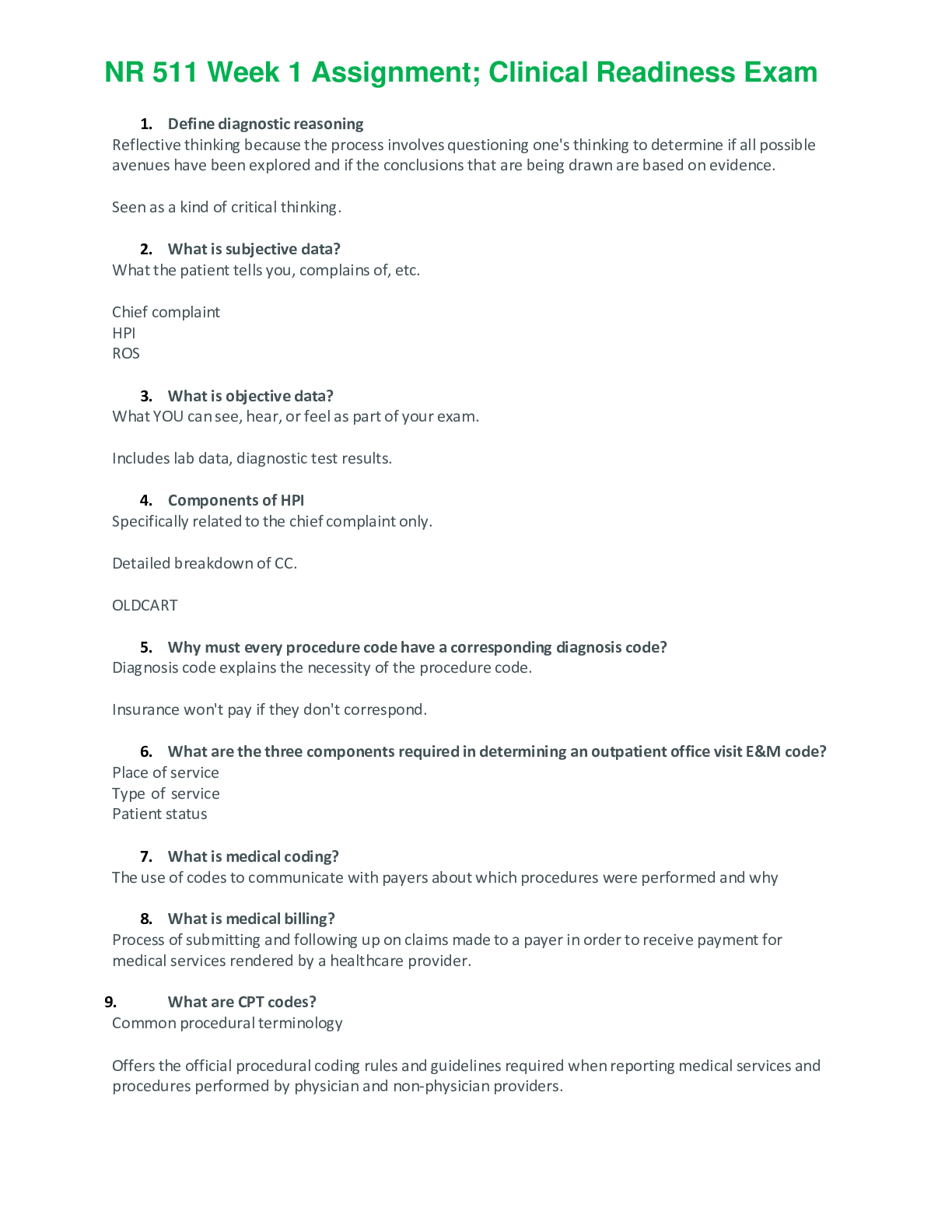
Reviews( 0 )
Document information
Connected school, study & course
About the document
Uploaded On
Jun 23, 2022
Number of pages
11
Written in
Additional information
This document has been written for:
Uploaded
Jun 23, 2022
Downloads
0
Views
16






.png)














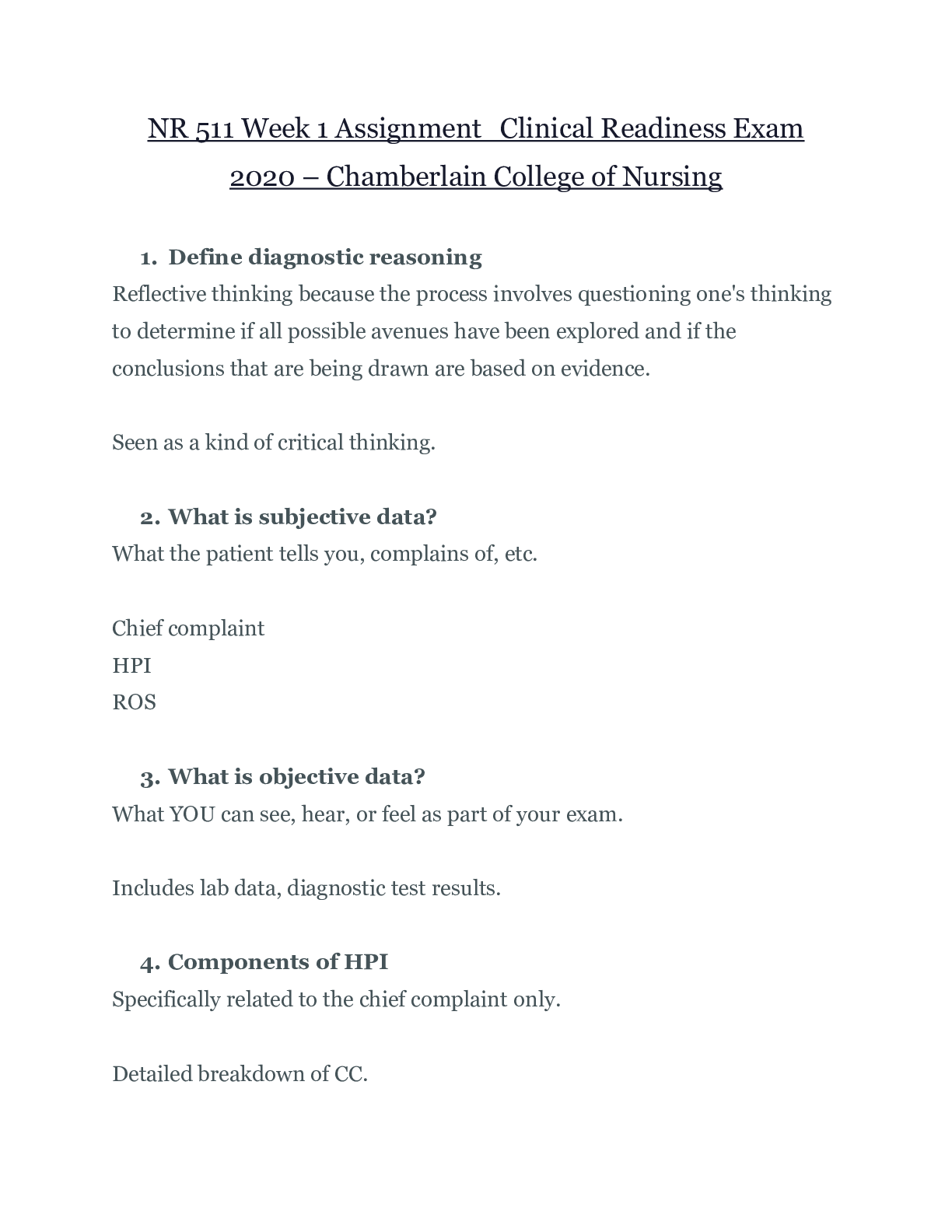
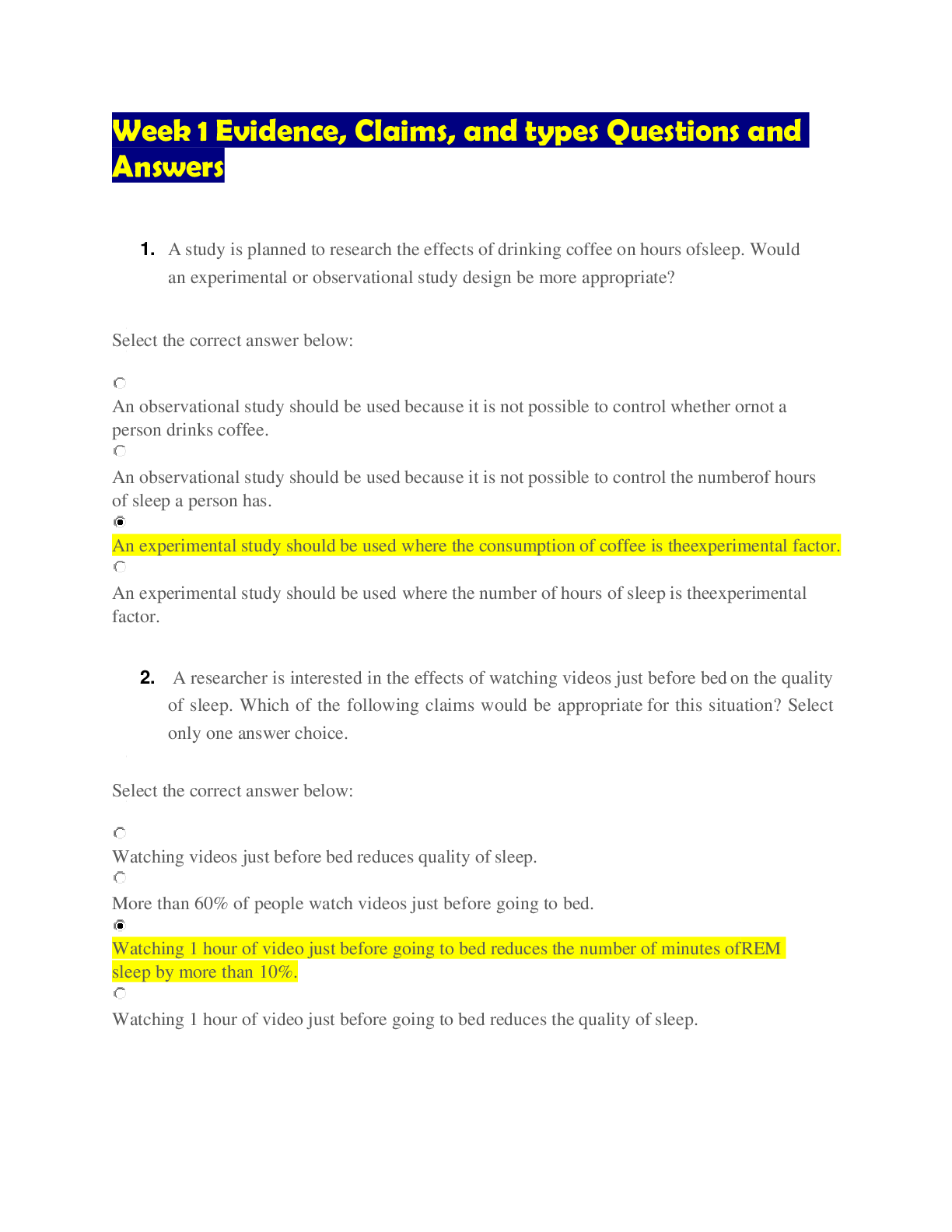



.png)
